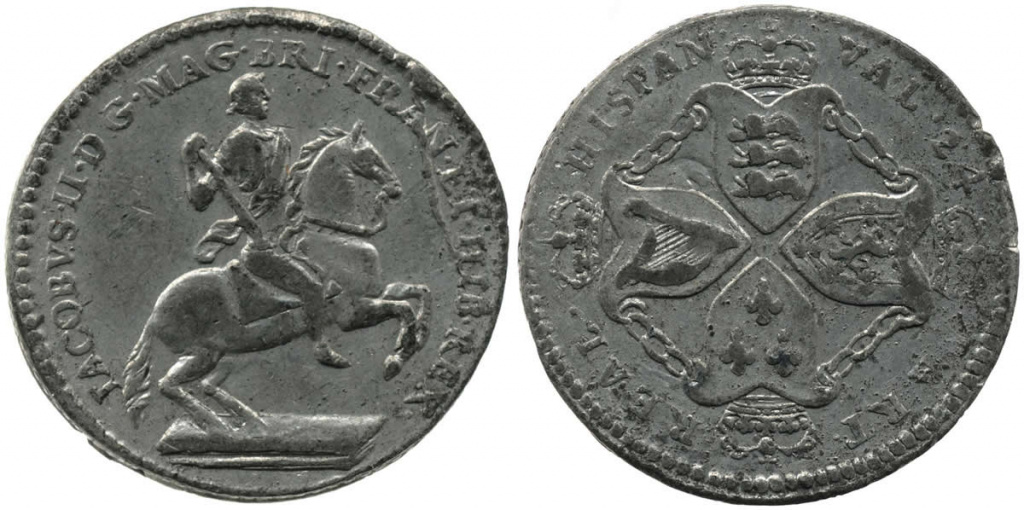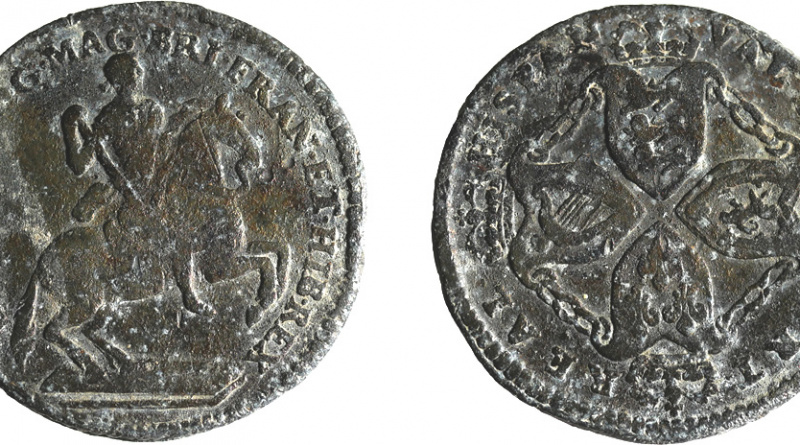Plantation Token
A coin, dated 1688, that was intended for use in the American plantations. Like most of the surviving examples, it is in poor condition. That is because it is made from tin, a most unsuitable metal for a coin. Below is a slightly better example, at the British Museum

The obverse shows James II riding a horse with the legend IACOBVS II D G MAG BRI FRAN ET HIB REX. The reverse has four crowned shields of England, Scotland, France and Ireland linked by chains, VAL 24 PART REAL HISPAN (translating to “Value a 24th part of a Spanish real”).
These coins are unusual for three reasons:
- First authorised coinage for the British colonies in America
- Only issue in pure tin for American use
- Only British coinage using a Spanish denomination
Tin coins
Problems with tin
The main drawback of using tin is that at temperatures below 13.2C it undergoes an allotropic transformation, known as “tin pesting”, which causes tin objects to decompose to powder.
In June 1661, the deputy Master of the Mint, Henry Slingsby, reported to the newly restored king on the relative merits of copper and tin. He was concerned with the ease that tin coins could be counterfeited and concluded that copper was the better metal for coins.1
Copper coinage
In 1672, the Royal Mint began producing copper half pence and farthings. It was the first time that they had minted any significant quantity of coinage in anything other than gold or silver.
Copper had its issues too; it was not produced in Great Britain in any quantity until 1690 and instead had to be imported from Sweden.
Support the Tin industry
In the latter part of the 17th Century the tin industry had been suffering due to the fall in prices. In 1686, the Crown “out of compassion of their circumstances” agreed to buy all tin produced in Cornwall and Devon at above the current market price. The contract included the coining of “pence, halfe pence and farthings of intrinsic value of Tynn throughout all his Majesty’s Dominions“. A personal meeting with James II was arranged for 19 June 1688 to sign the contract.2
On the face of it, that seems a good thing – support a domestic industry by finding a use for its product. By why did the king look on the tin industry so favourably and who benefitted from this decision.
John Granville, 1st Earl of Bath

The answer to both questions is one of his loyal supporters and adviser, John Granville. He had fought in the Civil War on the side of Charles I and created a knight. He became a Lord of the Bedchamber to the Prince of Wales, the future king, Charles II.
He mediated in negotiations between Charles II and George Monck, that led to the restoration of the Monarchy. On Charles’ restoration, much to Granville’s dismay, Monck was rewarded with the Dukedom of Albermarle and a pension of £7,000 per year.3
Granville would also needed to be rewarded with titles that produced income.
Lord of the Stannaries
The production of tin in Cornwall and Devon came under control of the Lord Warden of the Stannaries. The first Lord Warden was appointed by Richard I on 20 November 1197. Under the Commonwealth Parliament, Oliver Cromwell did away with the Duchy of Cornwall and Stannaries. The unregulated tin industry boomed and the ordinary miner did very well. So much so that in 1658, in St Just on the “Tin Coast” of North Cornwall, 155 men signed a declaration of allegiance to Cromwell.4
In 1660, when the monarchy was restored, Charles II, reintroduced the Stannaries and appointed Granville to the role of Lord Warden.
Negotiations with the king
However, with the decline in tin mining in the years that followed his appointment, Granville finances suffered. In recognition of his continuing service to the Crown, he was still very much in favour and was now also Lieutenant of Cornwall and Devon. In June 1688, he lead a delegation to the king to seek approval for the minting of tin coins. With him was Thomas Griffith and Thomas Hartopp and two merchants, Richard Holt and James Kelke.1 The king agreed.
Arrangements were made to have the coins minted at Skinners Hall by Richard Holt and an Elias Palmer.4
1/24th Real
There’s also the question of why a coin issued in Britain would have a Spanish denomination. The reasoning is contained in a letter accompanying the patterns from Richard Holt to the king in July 1688:
“… The Inscription on the Revers, Vis: vall 24. part Rial Hispan is because the said Coynes are intended to pass in his Majesty’s Plantacons & such parts of his Dominions where they only take Spanish money … and a Ryall being 6D Sterling in value it’s also convenient for his Majesty’s European Dominions.” That is, the coin would be worth a farthing.2
Restrike
The dies were cut by John Roettier one of England’s most famous engravers. As was customary at the time, the dies he cut became his property. Over a century later, his descendants sell his dies to a coin dealer called Matthew Young. He sold on many to the British Museum but he kept the 1/24th real dies and made some restrikes of the coins. The freshness of the tin made these restrikes easily distinguishable from the original but over time, as they too have suffered from pesting, this has become more difficult.2
Classification
In 1964 EP Newman classified the coin into 7 obverse and 7 reverse types.
Found coin

The found coin is a 2B. Obverse type 2 as the king’s head is directly under G, there is no stop after X and the hoof ends under right end base of E. The reverse is type B as there are 7 strings to the harp, lions’ heads rise to the left and the left fleur-de-lis is lower than the right.
British Museum coin

This coin is a 5D. Obverse type 5 as the head is between G and B, favouring B, gap between D and G, O in Jacobus is high and the hoof ends by X. The reverse is type D with 11 strings to the harp, small fleur-de-lis an lions with the latter being vertical.
The other significant characteristic is the die crack on the obverse between A and H. This marks it out as a restrike. Only three die combinations are known for restrikes; 4D, 4E and 5D. The 5D is most common and usually has the die crack. It has been suggested that restrikes can be distinguished by a lower tin content or die alignment although neither method has been satisfactorily proven.6
References
- COPPER v TIN COINS IN SEVENTEENTH-CENTURY ENGLAND by J. Keith Horsefield 1982
- The James II 1/24th Real for the American Plantations by Eric P Newman
- John Granville, 1st Earl of Bath, Wikipedia
- John Grenville: Lord Warden of the Stannaries, Penwith Local History Group
- Calendar of Treasury Books 1685-1689 p. 1981
- 1/24RL American Plantations Restrike PCGS

